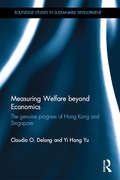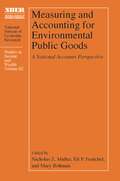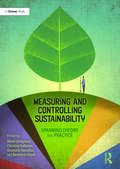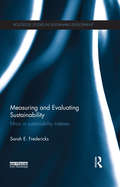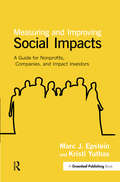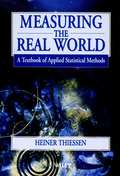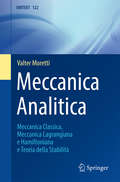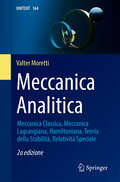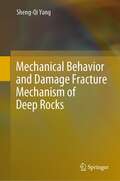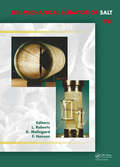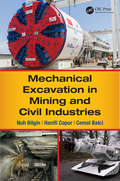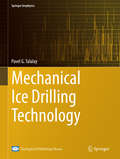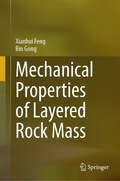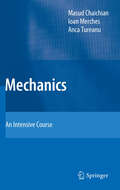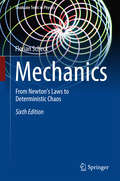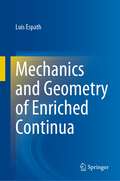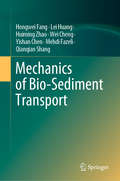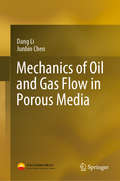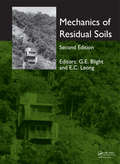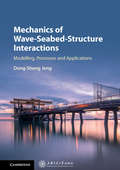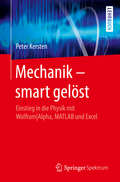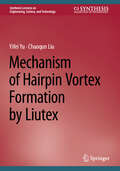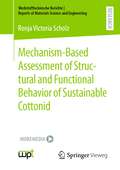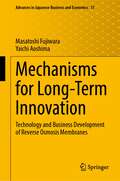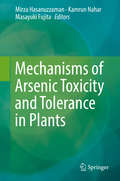- Table View
- List View
Measuring Welfare beyond Economics: The genuine progress of Hong Kong and Singapore (Routledge Studies in Sustainable Development)
by Claudio O. Delang Yi Hang YuDissatisfaction with the Gross Domestic Product (GDP) as an indicator of a country’s development or a population’s wellbeing led to the development of the Genuine Progress Indicator (GPI). The GPI is an aggregate index of over 20 economic, social and environmental indicators, and accounts for both the welfare benefits of economic growth, and the social and environmental costs which accompany that economic growth. The result is better information about the level of welfare or well-being of a country’s population. This book measures the GPI of Hong Kong and Singapore from 1968 to 2010. It finds that for both countries, economic output (as measured by the GDP) has grown more than welfare (as measured by the GPI), but important differences are also found. In Hong Kong, the GPI has grown for the whole period under consideration, while in Singapore the GPI has stalled from 1993. This is in line with most countries and is explained by the "threshold hypothesis" which states that beyond a certain level of economic development the benefits of further economic growth are outweighed by even higher environmental and social costs. The book argues that the growth of Hong Kong’s GPI is due to its favourable relationship with China and in particular its ability to export low-wage jobs and polluting industries, rather than successful domestic policies. A stalling or shrinking GPI calls for alternative policies than the growth economy promoted by neoclassical economists, and the book explores an alternative model, that of the Steady State Economy (SSE).
Measuring and Accounting for Environmental Public Goods: A National Accounts Perspective (National Bureau of Economic Research Studies in Income and Wealth)
by Nicholas Z. Muller, Eli P. Fenichel, and Mary BohmanProvides strategies and approaches for integrating natural capital into environmental statistics. While the importance of natural resources and the contributions of the environment to welfare are apparent, traditional national income and wealth accounting practices do not measure or value environmental public goods. This volume examines the conceptual and empirical basis for integrating natural capital—forests, oceans, and air—into the economic and environmental statistics that inform public policy. It offers innovative approaches to valuing nonmarket environmental goods and services, including strategies for capturing heterogeneity in measurement across types of capital, geography, and individuals. The chapters focus on measuring productivity with adjustments for pollution damage, developing a microdata infrastructure to advance our understanding of the distribution of environmental amenities and hazards, and estimating long-run sustainable development indicators. Case studies consider coastal assets, forests, and marine ecosystems, and develop strategies for implementing specific environmental-economic accounts such as environmental activity accounts and natural capital accounts for forests and the marine economy. As national income accounting standards are updated to incorporate expanded guidance on issues related to natural capital, this timely book will help inform decisions on the measurement and treatment of climate, air, water, and other public goods.
Measuring and Controlling Sustainability: Spanning Theory and Practice
by Bernhard Hirsch Adam Lindgreen Christine Vallaster Dr Shumaila YousofzaiEfforts to establish the measurement and control of sustainability have produced notable tools, but those instruments lack applicability in practice. Increasing the level of standardization of such tools also seems difficult to achieve, because the contexts surrounding the focal organizations differ considerably. Therefore, what we need is a systematic, interdisciplinary assessment of how to measure and control sustainability, so that we can establish an essential definition and up-to-date picture of the field. Measuring and Controlling Sustainability attempts to provide such an assessment in 17 chapters, organized into four main topic sections: (a) organizations and social value creation: concepts, responsibilities, and barriers; (b) accounting, measurement, performance, and diffusion of social value; (c) practical and managerial insights from real-life cases; and (d) choices, incentives, guidance, and ethics. This research anthology provides a comprehensive collection of cutting-edge theories and research that will further the development and advancement of measuring and controlling sustainable efforts in theory and managerial practice.
Measuring and Evaluating Sustainability: Ethics in Sustainability Indexes (Routledge Studies in Sustainable Development)
by Sarah E. FredericksThe indexes used by local, national, and international governments to monitor progress toward sustainability do not adequately align with their ethical priorities and have a limited ability to monitor and promote sustainability. This book gives a theoretical and practical demonstration of how ethics and technical considerations can aid the development of sustainability indexes to overcome this division in the literature and aid sustainability initiatives. Measuring and Evaluating Sustainability develops and illustrates methods of linking technical and normative concerns during the development of sustainability indexes. Specifically, guidelines for index development are combined with a pragmatic theory of ethics that enables ethical collaboration among people of diverse ethical systems. Using the resulting method of index development, the book takes a unique applied turn as it ethically evaluates multiple sustainability indexes developed and used by the European Commission, researchers, and local communities and suggests ways to improve the indexes. The book emphasizes justice as it is the most prevalent ethical principle in the sustainability literature and most neglected in index development. In addition to the ethical principles common to international sustainability initiatives, the book also employs a variety of religious and philosophical traditions to ensure that the ethical evaluations performed in the text align with the ideals of the communities using the indexes and foster cross-cultural ethical dialogue. This volume is an invaluable resource for students, researchers and professionals working on sustainability indicators and sustainability policy-making as well as interdisciplinary areas including environmental ethics; environmental philosophy; environmental or social justice; ecological economics; businesses sustainability programs; international development and environmental policy-making.
Measuring and Improving Social Impacts: A Guide for Nonprofits, Companies and Impact Investors
by Marc J. Epstein Kristi YuthasIdentifying, measuring and improving social impact is a significant challenge for corporate and private foundations, charities, NGOs and corporations. How best to balance possible social and environmental benefits (and costs) against one another? How does one bring clarity to multiple possibilities and opportunities? Based on years of work and new field studies from around the globe, the authors have written a book for managers that is grounded in the best academic and managerial research.It is a practical guide that describes the steps needed for identifying, measuring and improving social impact. This approach is useful in maximizing the impact of different types of investments, including grants and donations, impact investments, and commercial investments.With numerous examples of actual organizational approaches, research into more than fifty organizations, and extensive practical guidance and best practices, Measuring and Improving Social Impacts fills a critical gap.
Measuring the Real World: A Textbook of Applied Statistical Methods
by Heiner ThiessenOffers an introduction in Applied Statistics focusing on some of the statistics of today's society--world wide population growth, economic developments, international trade and energy consumption, global maldistribution of income and absorption of resources, depletion of species and resources, environmental changes, and human problems.
Meccanica Analitica: Meccanica Classica, Meccanica Lagrangiana e Hamiltoniana e Teoria della Stabilità (UNITEXT #122)
by Valter MorettiIl testo parte da una rivisitazione teorica della meccanica classica newtoniana e del suo linguaggio matematico che si conclude con un'analisi critica della meccanica classica newtoniana. Si passa quindi alle formulazioni lagrangiane e hamiltoniane della meccanica classica, discutendo in particolare il rapporto tra simmetrie e costanti del moto all'interno di varie versioni del teorema di Noether e analoghi risultati. I capitoli sulla meccanica hamiltoniana, oltre al materiale standard come le parentesi di Poisson, la geometria simplettica, la formulazione di Hamilton-Jacobi e principi variazionali, includono alcuni risultati teorici importanti come il teorema di Liouville e il teorema di ricorrenza di Poincaré. La teoria della stabilità è introdotta e discussa nell'approccio di Liapunov. Il linguaggio adottato in tutto il testo è quello della geometria differenziale, che in ogni caso viene introdotta gradualmente. Un complemento finale include la teoria di base dei sistemi di equazioni differenziali ordinarie e dei sistemi con alcune generalizzazioni alla teoria sulle varietà. Diverse appendici introducono alcuni strumenti matematici come la teoria delle forme differenziali, la derivata di Lie e la teoria dell'integrazione su varietà. Il libro include diversi esercizi risolti.Il libro si rivolge agli studenti di Matematica e Fisica per i corsi di Meccanica Razionale e Meccanica Analitica.
Meccanica Analitica: Meccanica Classica, Meccanica Lagrangiana, Hamiltoniana, Teoria della Stabilità, Relatività Speciale (UNITEXT #164)
by Valter MorettiIl testo parte da una rivisitazione teorica della meccanica classica newtoniana e del suo linguaggio matematico che si conclude con un'analisi critica della meccanica classica newtoniana. Si passa quindi alle formulazioni lagrangiane e hamiltoniane della meccanica classica, discutendo in particolare il rapporto tra simmetrie e costanti del moto all'interno di varie versioni del teorema di Noether e analoghi risultati. I capitoli sulla meccanica hamiltoniana, oltre al materiale standard come le parentesi di Poisson, la geometria simplettica, la formulazione di Hamilton-Jacobi e principi variazionali, includono alcuni risultati teorici importanti come il teorema di Liouville e il teorema di ricorrenza di Poincaré. La teoria della stabilità è introdotta e discussa nell'approccio di Lyapunov. Nella seconda edizione è stata aggiunta una descrizione matematica della teoria della relatività speciale e di alcuni suoi sviluppi nell'ambito della formulazione lagrangiana ed hamiltoniana. Il linguaggio adottato in tutto il testo è quello della geometria differenziale, che in ogni caso viene introdotta gradualmente. Un primo complemento finale discute gli assiomi fisici su cui si basa la teoria della relatività speciale e come si passa da tali assiomi alla formulazione matematica. Un secondo complemento include la teoria di base dei sistemi di equazioni differenziali ordinarie e dei sistemi con alcune generalizzazioni alla teoria sulle varietà. Diverse appendici introducono alcuni strumenti matematici come la teoria delle forme differenziali, la derivata di Lie e la teoria dell'integrazione su varietà. Il libro include diversi esercizi risolti. Il libro si rivolge agli studenti di Matematica e Fisica per i corsi di Meccanica Razionale e Meccanica Analitica.
Mechanical Behavior and Damage Fracture Mechanism of Deep Rocks
by Sheng-Qi YangThis book presents mainly experimental studies on the mechanical behavior and damage fracture mechanism of deep rocks including sandstone, marble, mudstone and granite, combining with several advanced technologies of X-ray micro-CT and AE monitoring.It has several unique features: 1) Investigates the influence of loading path on triaxial strength and deformation behavior of sandstone and marble; 2) Analyzes the effect of borehole size on triaxial strength and deformation behavior of hollow sandstone; 3) Explores the influence of high temperature on triaxial deformation and permeability behavior of sandstone and granite; 4) to reveal the damage fracture mechanism of deep rocks using spatial AE techniques and X-ray micro CT observations. This work will appeal to a wide readership from technicians in the field of geotechnical engineering and engineering geology to scholars carrying out research in the rock mechanics.
Mechanical Behaviour of Salt VIII
by Lance Roberts Frank Hansen Kirby MellegardTechnical contributions contained in this volume characterize continuity of science, engineering and modeling regarding the mechanical behavior of salt. These papers evidence relationships from microscopic dislocation structure to modeling applications over kilometer dimensions, a reach of more than ten orders of magnitude. The book is arranged alo
Mechanical Excavation in Mining and Civil Industries
by Nuh Bilgin Hanifi Copur Cemal BalciThe secret to streamlined project scheduling is a solid understanding of basic rock cutting mechanics. Comparing theoretical values with experimental and real-world results, Mechanical Excavation in Mining and Civil Industries explains rock cutting theories for chisel, conical, disc, and button cutters. The authors provide numerical examples on the effect of independent variables on dependent variables, as well as examples from real-life mining and civil engineering jobs. The book assists students and engineers in machinery selection and performance prediction, and discusses rock cutting mechanics and mechanical miners.
Mechanical Ice Drilling Technology
by Pavel G. TalalayThis book provides a review of mechanical ice drillingtechnology, including the design, parameters, and performance of various toolsand drills for making holes in snow, firn and ice. The material presents the historicaldevelopment of ice drilling tools and devices from the first experience takenplace more than 170 years ago to the present day and focuses on the modernvision of ice drilling technology. It is illustrated with numerous pictures, many of them published for the first time. This book is intended for specialistsin ice core sciences, drilling engineers, glaciologists, and can be useful forhigh-school students and other readers who are very interested in engineeringand cold regions technology.
Mechanical Properties of Layered Rock Mass
by Xianhui Feng Bin GongThis book focuses on revealing the anisotropic mechanical behaviors of layered rock masses subjected to various dynamic loads, by means of theoretical analyses, physical experiments and numerical simulations. It aims at elucidating the effects of structural planes on the mechanical properties, fracture characteristics and failure modes of rock masses. Notably, the book introduces a novel strength criterion specifically designed to represent shale strength under dynamic impact conditions. Serving as a valuable resource, this work is intended to benefit researchers and professionals involved in shale gas extraction, blasting engineering, and mining engineering. Additionally, it is well-suited as a textbook for graduate students in above disciplines and other related subjects.
Mechanics
by Masud Chaichian Anca Tureanu Ioan MerchesMechanics is one of the oldest and at the same time newest disciplines, in the sense that there are methods and principles developed first in mechanics but now widely used in almost all branches of physics: electrodynamics, quantum mechanics, classical and quantum field theory, special and general theory of relativity, etc. More than that, there are some formalisms like Lagrangian and Hamiltonian approaches, which represent the key stone for the development of the above-mentioned disciplines. During the last 20-25 years, classical mechanics has undergone an important revival associated with the progress in non-linear dynamics, applications of Noether's theorem and the extension of variational principles in various interdisciplinary sciences (for instance, magnetofluid dynamics). Thus, there ought to exist a book concerned with the applied analytical formalism, first developed in the frame of theoretical mechanics, which has proved to be one of the most efficient tools of investigation in the entire arena of science.The present book is an outcome of the authors' teaching experience over many years in different countries and for different students studying diverse fields of physics. The book is intended for students at the level of undergraduate and graduate studies in physics, engineering, astronomy, applied mathematics and for researchers working in related subjects. We hope that the original presentation and the distribution of the topics, the various applications in many branches of physics and the set of more than 100 proposed problems, shall make this book a comprehensive and useful tool for students and researchers. The present book is an outcome of the authors' teaching experience over many years in different countries and for different students studying diverse fields of physics. The book is intended for students at the level of undergraduate and graduate studies in physics, engineering, astronomy, applied mathematics and for researchers working in related subjects. We hope that the original presentation and the distribution of the topics, the various applications in many branches of physics and the set of more than 100 proposed problems, shall make this book a comprehensive and useful tool for students and researchers.
Mechanics
by Florian ScheckPurpose and Emphasis. Mechanics not only is the oldest branch of physics but was and still is the basis for all of theoretical physics. Quantum mechanics can hardly be understood, perhaps cannot even be formulated, without a good knowledge of general mechanics. Field theories such as electrodynamics borrow their formal framework and many of their building principles from mechanics. In short, throughout the many modem developments of physics where one fre quently turns back to the principles of c1assical mechanics its model character is feIt. For this reason it is not surprising that the presentation of mechanics reflects to some extent the development of modem physics and that today this c1assical branch of theoretical physics is taught rather differently than at the time of Arnold Sommerfeld, in the 1920s, or even in the 1950s, when more emphasis was put on the theory and the applications of partial-differential equations. Today, symme tries and invariance principles, the structure ofthespace-time continuum, and the geometrical structure of mechanics play an important role. The beginner should realize that mechanics is not primarily the art of describing block-and-tackles, coIIisions of billiard balls, constrained motions of the cylinder in a washing ma chine, or bicycle riding.
Mechanics and Geometry of Enriched Continua
by Luis EspathThis monograph presents a comprehensive and rigorous new framework for the theoretical description and modelling of enriched continua. In other words, continua that exhibit more complex behaviour than their conventional counterparts and, in particular, multicomponent systems. It employs gradient theories, exhibiting multiple transition layers described by phase fields. As a point of departure, we account for multiple continuum kinematic processes, including motion and various phase fields. These gradient theories arise by considering various kinematic processes which are tightly linked to the level of the arbitrariness of the Euler–Cauchy cuts. The surface defining the Euler–Cauchy cut may lose its smoothness along a curve, and the curve may also lose its smoothness at a point. Additionally, we postulate the principle of virtual power on surfaces. Then, the first and second laws of thermodynamics with the power balance provide suitable and consistent choices for the constitutive equations. Finally, the complementary balances, namely the balances on surfaces, are tailored to coincide with different parts of the boundaries of the body. These surface balances are then called environmental surface balances and aid in determining suitable and consistent boundary conditions. Ultimately, the environmental surface power balance is relaxed to yield an environmental surface imbalance of powers, rendering a more general type of boundary condition.A detailed introduction sets the scene for the mathematical chapters that follow, ensuring that graduate students and newcomers can profit from the material presented.
Mechanics of Bio-Sediment Transport
by Wei Cheng Hongwei Fang Lei Huang Huiming Zhao Yishan Chen Mehdi Fazeli Qianqian ShangThe main focus of this book is the transport mechanics of sediment particles coated with microbial biofilm, which is called bio-sediment. The book also addresses the question of how to measure and simulate the considerable variation in the properties of natural sediment associated with microbial biofilm, ranging from the micro-scale surface morphology to the macro-scale sediment transport. Nowadays most studies to elucidate the mechanisms of sediment transport have concentrated on physical-chemical sediment properties, little work explicitly coupled sediment dynamics and the environmental effects under the influence of micro-ecosystem, thus leaving a serious gap in water and sediment sciences as well as water ecological research. With respect to physical-chemical sediment properties, this book has been undertaken to evaluate and quantify the effect of biological factors - biofilm on sediment transport mechanics. The chapters cover topics including development of bio-sediment and its properties; model of biofilm growth on sediment substratum; bedform and flow resistance of bio-sediment bed; incipient velocity and settling velocity of bio-sediment; bedload and suspended load transport for bio-sediment; numerical simulation of bio-sediment transport. Besides, the measurement technology, analysis method and expression approach introduced in this book combine the characteristics of hydraulic, environmental and microbial research, having more immediate innovation. This book will be of interest to researchers, managers, practitioners, policy and decision makers, international institutions, governmental and non-governmental organizations, educators, as well as graduate and undergraduate students in the field of hydraulics and river dynamics. It will help to understand the relevance of sediment transport and biofilm growth under the role of aqueous micro-ecosystem, to introduce better tools for the simulation and prediction of bio-sediment transport, and to provide a scientific basis and application foundation for the research of interaction between sediment particles and ecological and environmental factors.
Mechanics of Oil and Gas Flow in Porous Media
by Dang Li Junbin ChenThis book discusses various aspects of percolation mechanics. It starts with the driving forces and driving modes and then examines in detail the steady state percolation of single-phase incompressible fluids, percolation law of natural gas and percolation of non-Newtonian fluids. Progressing from simple to complex concepts, it also analyzes Darcy’s law, providing a basis for the study of reservoir engineering, oil recovery engineering and reservoir numerical simulation. It serves as a textbook for undergraduate students majoring in petroleum engineering, petroleum geology and groundwater engineering, and offers a valuable reference guide for graduate students, researchers and technical engineers engaged in oil and gas exploration and development.
Mechanics of Residual Soils
by Charles SidebottomResidual soils are found in many parts of the world and are used extensively as construction materials for roads, embankments and dams, and to support the foundations of buildings, bridges and load-bearing pavements. The characteristics and engineering properties of residual soils can differ significantly from those of the more familiar transported
Mechanics of Wave-Seabed-Structure Interactions: Modelling, Processes And Applications (Cambridge Ocean Technology Series #7)
by Dong-Sheng JengOpening with recent advances in both the theoretical and physical models for wave-seabed-structure interactions, this book provides an updated look at the mathematics behind the interactions between sea, soil and man-made structures.<P><P>The main models are broken down into key equations, and their strengths and challenges are discussed. These models are then placed in context with industry-relevant examples, in both two and three dimensions. From seabed instability around offshore wind turbines, to soil conditions in response to the laying of submarine pipelines, this book takes a comprehensive look at a variety of wave-seabed-structure interactions. With important implications for the future of offshore infrastructure, this is an ideal resource for industry workers, undergraduate students, and researchers.<P> Focuses on integrated wave and seabed models, and marine infrastructures, in 2D and 3D.<P> Providing detailed descriptions of industry-relevant implications of soil instability due to marine infrastructure, the book is a vital resource for anyone in the geotechnical engineering field.<P> Includes updated and integrated models for seabed-structure interactions and the compiling effects of wave action, providing an easy basis for research.
Mechanik – smart gelöst
by Peter KerstenDieses Buch bietet Studierenden in MINT-Fächern eine optimale Hilfestellung beim Erlernen der Grundlagen der Physik. Typische Aufgaben der Mechanik werden dabei Schritt für Schritt erklärt und mit Hilfe leistungsstarker Software aus den Bereichen Tabellenkalkulation, Computeralgebra und technisch-wissenschaftlichem Rechnen gelöst. Die dabei verwendeten Programme (Excel®, der Internetdienst Wolfram|Alpha® sowie die Software MATLAB®) sind sowohl auf Desktop-Rechnern, als auch als Apps auf mobilen Endgeräten wie Smartphones oder Tablets verfügbar – und damit immer schnell zur Hand. Das Fähigkeit mit diesen Programmen zu arbeiten kann auch im weiteren Studienverlauf und später in der beruflichen Praxis von großen Nutzen sein. Nach einer kompakten Einführung in mathematische Methoden und die verwendeten Programme deckt das Buch dabei die Bereiche der klassischen Mechanik mit den Teilgebieten Kinematik und Dynamik ab und liefert somit eine ideale Unterstützung für Einführungsvorlesungen in Physik an Hochschulen. Allen Studierenden, die sich beim Lösen von Aufgaben in der Physik schon einmal eine kleine Hilfestellung gewünscht haben, die einfach mal einen Funktionsverlauf visualisieren, eine Gleichung ohne Papier und Bleistift lösen oder das eigene Rechenergebnis überprüfen möchten, wird das vorliegende Buch ein praktischer und wertvoller Begleiter sein.
Mechanism of Hairpin Vortex Formation by Liutex (Synthesis Lectures on Engineering, Science, and Technology)
by Chaoqun Liu Yifei YuThis book presents the importance of the mechanism of hairpin vortex formation to understanding flow transition, turbulence, and flow control. This book blends direct numerical simulation (DNS) and mathematical analysis with experiments to create a foundation for understanding turbulence. The authors discuss hairpin vortex as a main component of transitional flow and turbulent flow. In addition, Liutex is utilized and described as a theoretical system that presents valid tools for turbulence research. Readers are exposed to understanding 3D and non-linear instability; the Lambda vortex formation; sweeps, ejections, and shear instability; the Kelvin-Helmholtz instability and vortex ring formation; and turbulence generation and sustenance.
Mechanism-Based Assessment of Structural and Functional Behavior of Sustainable Cottonid (Werkstofftechnische Berichte │ Reports of Materials Science and Engineering)
by Ronja Victoria ScholzRonja Victoria Scholz assesses the performance of cellulose-based Cottonid for implementation as sustainable construction material. Quasi-static and fatigue tests are performed in varying hygrothermal test conditions using mechanical testing systems in combination with integrable climate chambers. To investigate humidity-driven actuation properties, customized specimen holders are designed. Accompanying microstructural in situ experiments in analytical devices enable a profound understanding of effective material-specific damage and failure mechanisms. The findings are transferred into strength-deformation diagrams as well as Woehler curves, which enable a comparative evaluation of several process-related and environmental influencing factors and can directly be used for dimensioning of Cottonid elements for structural applications. The interpretation of thermoelastic material reponse during loading is used as scientific value for lifetime prediction. Comprehensive investigations on industrial standard materials as well as structurally optimized Cottonid variants provide a scientific basis for categorizing material’s structural and functional performance towards common technical plastics and wood.
Mechanisms for Long-Term Innovation: Technology and Business Development of Reverse Osmosis Membranes (Advances in Japanese Business and Economics #31)
by Yaichi Aoshima Masatoshi FujiwaraThis book explores how a long-term innovation can take place based on historical analyses of the development of reverse osmosis (RO) membrane from the early 1950s to the mid-2010s. The RO membrane is a critical material for desalination that is a key to solve water shortages becoming serious in many places of the world. The authors conducted in-depth field studies as well as analyses of rich archival data to demonstrate how researchers, engineers, managers, entrepreneurs, and policymakers interacted each other for this material innovation to be realized. A series of historical analyses in this book uncovered that initial government supports, strategic niche markets, emergence of breakthrough technology, and company-specific rationales played significant roles for companies to overcome four types of uncertainty, technological, market, competition, and social/organizational ones, and enabled the companies to persistently invest in the development and commercialization of the RO membrane. This book depicts that innovation does not arise on a sudden, but that it is actualized through long lasting process with turns and twists, which is driven by many non-economic rationales beyond economic motives.
Mechanisms of Arsenic Toxicity and Tolerance in Plants
by Masayuki Fujita Mirza Hasanuzzaman Kamrun NaharArsenic is likely the most talked-about metalloid in the modern world because of its toxic effects on both animal and plants. Further, arsenic pollution is now producing negative impacts on food security, especially in many south Asian countries. Since plants are a major food source, their adaptation to As-rich environments is essential, as is being informed about recent findings on multifarious aspects of the mechanisms of arsenic toxicity and tolerance in plants. Although numerous research works and review articles have been published in journals, annual reviews and as book chapters, to date there has been no comprehensive book on this topic.This book contains 19 informative chapters on arsenic chemistry, plant uptake, toxicity and tolerance mechanisms, as well as approaches to mitigation. Readers will be introduced to the latest findings on plant responses to arsenic toxicity, various tolerance mechanisms, and remediation techniques. As such, the book offers a timely and valuable resource for a broad audience, including plant scientists, soil scientists, environmental scientists, agronomists, botanists and molecular biologists.
